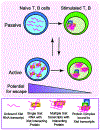Enjoy the silence: X-chromosome inactivation diversity in somatic cells
- PMID: 31108425
- PMCID: PMC6759402
- DOI: 10.1016/j.gde.2019.04.012
Enjoy the silence: X-chromosome inactivation diversity in somatic cells
Abstract
The imbalance of sex chromosomes between females (XX) and males (XY) necessitates strict regulation of X-linked gene expression. X-Chromosome Inactivation (XCI) selects one X for transcriptional silencing in the early embryo, generating an epigenetically distinct and transcriptionally silent X that is maintained into adulthood. Some genes on the inactive X escape XCI, and human somatic cells have a greater number of escape genes compared to mice. Advances with single-cell technologies have revealed human-specific escape genes in fibroblasts and immune cells, some of which exhibit cell and tissue specificity. Here, we review recent discoveries of dynamic XCI in female immune cells, which have changed our understanding of XCI maintenance, and discuss how some X-linked genes might become overexpressed in female-biased autoimmunity.
Copyright © 2019 Elsevier Ltd. All rights reserved.
Conflict of interest statement
Conflict of interest statement
The authors have declared that there is no conflict of interest.
Figures


References
-
- Lyon MF: Gene action in the X-chromosome of the mouse (mus musculus L.). Nature 1961, 190:372–373. - PubMed
-
- Penny GD, Kay GF, Sheardown SA, Rastan S, Brockdorff N: Requirement for Xist in X chromosome inactivation. Nature 1996, 379:131–137. - PubMed
-
- Heard E, Rougeulle C, Arnaud D, Avner P, Allis CD, Spector DL: Methylation of histone H3 at Lys-9 Is an early mark on the X chromosome during X inactivation. Cell 2001, 107:727–738. - PubMed
Publication types
MeSH terms
Grants and funding
LinkOut - more resources
Full Text Sources

